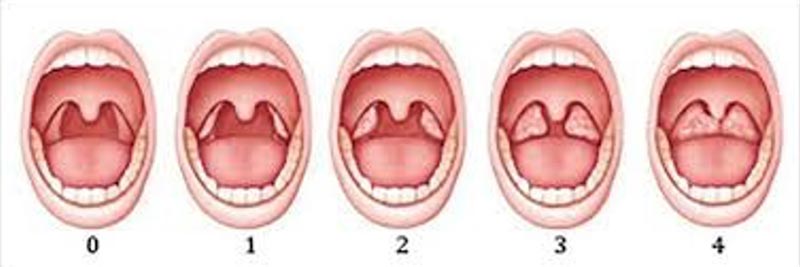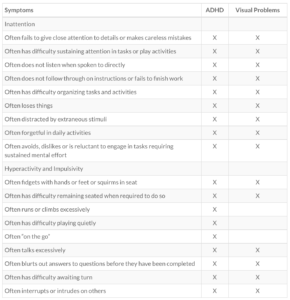Evaluation Process
In order to confirm a diagnosis of ADHD, a full comprehensive ADHD in children assessment process evaluation may be necessary.
Vision screening
Attention deficit disorder (ADD) and attention deficit hyperactivity disorder (ADHD) are conditions in which children cannot concentrate on particular tasks. However, these conditions have high correlation with convergence insufficiency, a functional visual issue in which children cannot focus on a particular object or person.
15 of the 18 symptoms used to diagnose ADD and ADHD are also symptoms of vision related learning problems. In fact, children with any vision problem can exhibit the same signs as ADD/ADHD.
Impaired attention span may be a result of visual problems. A peer-reviewed academic study published in scientific journals revealed that the incidence of ADHD is twice as much in children suffering from vision problems. Visual problems can affect the child’s “executive function” by impairing their planning, attention span, processing speed, and temporospatial organization. As a result, the child feels anxious, fails to complete their homework, and behaves in a hyperactive or restless manner.
Auditory Screening
Sleep disorder screening
Obstructive Sleep Apnea Syndrome (OSAS) may contribute to ADHD symptomatology. Treatment of OSA may resolve impaired attention span. OSAS frequently occurs in children who have hypertrophic tonsils. Given our interdisciplinary approach, we will screen and, if necessary, test kids for OSAS. Screening for other sleer-related issues will also be completed.

This picture shows how tonsils obstruct the airway, cause sleep apnea and impaired attention span.
Neurological issues
- Epilepsy
- Neuroimaging studies including EEG study (i.e., seizure disorder, head injury; other neurological conditions)
- Quantitative electroencephalography (q-EEG) is a valuable addition to the standard clinical evaluation, by eliciting objective evidence of significant statistical deviations in electrophysiological measures of brain activity from expected values for the child’s age.
- Exposure to toxic substances
- Blood tests (lead toxicity; hyperthyroidism, hepatic disease etc.)
The role of Quantitative electroencephalography & Neuro-Optometric assessments in the evaluation of attention deficit disorder
Quantitative electroencephalography (q-EEG) is a valuable addition to the standard clinical evaluation, by eliciting objective evidence of significant statistical deviations in electrophysiological measures of brain activity from expected values for the child’s age.
Neurological issues
Quantitative electroencephalography (q-EEG) is a valuable addition to the standard clinical evaluation, by eliciting objective evidence of significant statistical deviations in electrophysiological measures of brain activity from expected values for the child’s age.
What are the similarities between ADD/ADHD and vision issues?

A broad range of skills will be measured during the neuropsychological evaluation including:
Academic skills: reading (rate and comprehension), writing, math
Intelligence (thinking, ability to process, interpret words)
Identifying images/targets (sustained, selective/divided attention)
Recalling visual and verbal information (words/pictures)
Drawing/copying pictures (visual motor integration; fine motor skills)
Planning, organization, behavioral control (executive functioning skills)
Problem solving skills/reasoning ability (i.e., solving puzzles using hands on activities such as blocks, visual and verbal presentations, etc.).
Emotional functioning/relationships (child’s feelings) will be assessed by in-person testing taking behavior (observation), questions and answers, along with analysis of rating scales (parent, teacher, self-report)
Language/speech (expressive and receptive skills)
*Linguistic/cognitive processing
*Use of vocal sounds (phonological)
*Ability to hear sounds (audiological function)
Interview with the parents:It is important to determine how long the child has been experiencing ADHD symptoms and if the symptoms are occurring in more than one setting (i.e., home and school). The clinician will get a detailed account of the child’s daily routine and symptoms in the home, school and social settings. The clinician may speak with the parents separately (may be over the phone before the initial meeting) and will also include an interview both the parent and child in person during the initial visit. The parents will also be asked to fill out a parent’s rating scale on their child’s overall functioning (i.e.., behaviorally, academically, socially, and emotionally).
Interview with the child: This interview (“informal”) may be conducted at the beginning of the testing period, when the child is already comfortable in the environment and will be able to speak freely to the clinician with respect to school, home and friends. These questions will be age appropriate such as “What do you enjoy most about school? Least? The child/adolescent will also be asked (if age appropriate) to answer questions on a self-report scale regarding his/her overall functioning (i.e.., behaviorally, academically, socially, and emotionally).
Interview with the teacher: It is important to determine how the child behaves in the classroom along with his peers at recess, and how the child is performing academically. The teacher will also be asked to fill out a teacher’s rating scale. These questions will address all aspects of the child’s functioning at school (i.e.., behaviorally, academically, socially, and emotionally).
Complete review of personal, family and medical history: This will include a thorough review of the medical records from the pediatrician including results of tests of hearing and eyesight. This will also include a complete personal/family history from the parents and any prior medications prescribed for the child (including current medications).
Comprehensive Neuropsychological Evaluation: This assessment will include all aspects of cognitive, academic, behavioral and emotional functioning. Cognitive/academic and behavioral functions will be assessed using a set of standardized tests (utilizing paper and pencil, question and answer, computer-based assessments). Differentials include Specific learning and/or developmental disorders, auditory/visual processing disorders, psychological/psychiatric disorders, along with other neurological/medical conditions described below).
Quantitative electroencephalography & Neuro-Optometric:
Quantitative electroencephalography (q-EEG) is a valuable addition to the standard clinical evaluation, by eliciting objective evidence of significant statistical deviations in electrophysiological measures of brain activity from expected values for the child’s age.
Vision Assessment with ADHD is critical when diagnosing children as the symptoms are very similar. It is important to test for all of these necessary visual skills and can develop/train them if they are lacking.
*Assessment-Continuum of Auditory Processing including acoustic, phonological/linguistic, linguist/cognitive-deficits in the transition (acoustic/phonemic processing) between auditory and language processing may require a consultation with an audiologist and/or speech/language pathologist.
The Continuum of Processing: Periphery auditory system, Central Auditory Processing, phonemic processing, language processing and executive functions.
*Central Auditory Processing Disorder (CAPD) -deficit in a person’s ability to internally process and/or comprehend sounds.
Assessment of Central Visual Processing (Visual Screening battery-RightEye Vision System*): Neuropsychology of Eye Movements: Identifying behaviorally significant central nervous system dysfunction/oculomotor abnormalities.
*Oculomotor recording and analysis by an FDA-cleared instrument-RightEye Vision System and backed by over 30 years of scientific research.
*The following medical conditions will be further screened for(may cause impaired attention span, etc.) when indicated by the Neurologist:
Neuroimaging studies including EEG study (i.e., seizure disorder, head injury; other neurological conditions)
Sleep studies (narcolepsy; obstructive sleep apnea) including further screening for hypertrophic tonsils
Blood tests (lead toxicity; hyperthyroidism, hepatic disease etc.)
